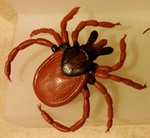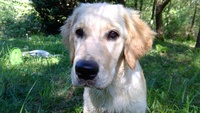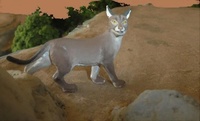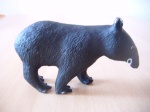| | Mathison Museum of Natural History |  |
|
+16Megaptera Taos George lucky luke Jill Saarlooswolfhound landrover Joliezac Caracal pipsxlch Bonnie Pardofelis Kikimalou rogerpgvg Roger bmathison1972 20 posters |
|
| Author | Message |
|---|
bmathison1972

Country/State : Salt Lake City, UT
Age : 52
Joined : 2010-04-13
Posts : 6331
 |  Subject: Re: Mathison Museum of Natural History Subject: Re: Mathison Museum of Natural History  Wed Jul 13, 2022 12:32 pm Wed Jul 13, 2022 12:32 pm | |
| Species: Acanthophis antarcticus (Shaw & Nodder, 1802) (common death adder) About the Figure: Manufacturer: K&M International Series: Australia's Deadliest Nature Tube Year of Production: 2018 Size/Scale: Figure 8.3 cm across its greatest widths. Measured along midline, body length 20.0 cm for a scale of 1:3.5-1:5 Frequency of species in toy/figure form (at time of posting): Very rare Miscellaneous Notes: There are two other figures of this species I am aware of, and those are both by Cadbury for the Australian and UK releases of their Yowies collection; all three figures (including today's) are variously stylized. About the Animal: Geographic distribution: Eastern and southern coastal Australia, Papua New Guinea Habitat: Rainforest, woodlands, grasslands, heathland Diet: Small mammals and birds IUCN Status (at time of posting): Least Concern Miscellaneous Notes: As its name suggests, A. antarcticus can delivery a potentially lethal bite. Its venom contains postsynaptic neurotoxin which can cause paralysis or death. It has also been documented that A. antarcticus can deliver the fastest strike of any of Australia's numerous venomous snakes. [You must be registered and logged in to see this image.] |
|
  | |
Bonnie

Country/State : UK
Age : 18
Joined : 2020-10-14
Posts : 5584
 |  Subject: Re: Mathison Museum of Natural History Subject: Re: Mathison Museum of Natural History  Wed Jul 13, 2022 12:56 pm Wed Jul 13, 2022 12:56 pm | |
| Interesting species, nice model, and quite a terrifying name!!  |
|
  | |
Caracal

Country/State : France
Age : 65
Joined : 2018-10-24
Posts : 7003
 |  Subject: Re: Mathison Museum of Natural History Subject: Re: Mathison Museum of Natural History  Wed Jul 13, 2022 2:18 pm Wed Jul 13, 2022 2:18 pm | |
|
Last edited by Caracal on Wed Jul 13, 2022 11:33 pm; edited 1 time in total |
|
  | |
widukind

Country/State : Germany
Age : 48
Joined : 2010-12-30
Posts : 44605
 |  Subject: Re: Mathison Museum of Natural History Subject: Re: Mathison Museum of Natural History  Wed Jul 13, 2022 9:42 pm Wed Jul 13, 2022 9:42 pm | |
| |
|
  | |
bmathison1972

Country/State : Salt Lake City, UT
Age : 52
Joined : 2010-04-13
Posts : 6331
 |  Subject: Re: Mathison Museum of Natural History Subject: Re: Mathison Museum of Natural History  Thu Jul 14, 2022 12:41 pm Thu Jul 14, 2022 12:41 pm | |
| Species: Gasteracantha cancriformis (Linnaeus, 1758) (spiny orbweaver) About the Figure: Manufacturer: K&M International Series: Spiders Bulk Year of Production: 1997 Size/Scale: Body width 3.0 cm for a scale of 3:1-2.3:1 Frequency of species in toy/figure form (at time of posting): Unique Miscellaneous Notes: Gasteracantha canriformis is sexually dimorphic (see below) and this figure depicts a female. About the Animal: Geographic distribution: Southeastern United States, Central and South America, Caribbean; adventive in Hawaii Habitat: Woodland edges, citrus orchards, parks and gardens Diet: Flying insects IUCN Status (at time of posting): Not Evaluated Miscellaneous Notes: Gasteracantha cancriformis exhibits marked sexual dimorphism. Females (as shown here) are larger, measuring 5-9 mm long by 10-13 mm wide, and have six prominent spines adorning the abdomen. Males are smaller (2-3 mm long), are longer than wide, and their abdominal adornments are reduced to 4-5 stubby knobs. [You must be registered and logged in to see this image.] |
|
  | |
Caracal

Country/State : France
Age : 65
Joined : 2018-10-24
Posts : 7003
 |  Subject: Re: Mathison Museum of Natural History Subject: Re: Mathison Museum of Natural History  Thu Jul 14, 2022 7:11 pm Thu Jul 14, 2022 7:11 pm | |
| What a design!  |
|
  | |
pipsxlch

Country/State : US/Florida
Age : 56
Joined : 2015-03-13
Posts : 2848
 |  Subject: Re: Mathison Museum of Natural History Subject: Re: Mathison Museum of Natural History  Fri Jul 15, 2022 4:15 am Fri Jul 15, 2022 4:15 am | |
| I see those all the time lol. They're neat spiders. |
|
  | |
widukind

Country/State : Germany
Age : 48
Joined : 2010-12-30
Posts : 44605
 |  Subject: Re: Mathison Museum of Natural History Subject: Re: Mathison Museum of Natural History  Fri Jul 15, 2022 6:42 am Fri Jul 15, 2022 6:42 am | |
| - Caracal wrote:
- What a design!
 I agree |
|
  | |
bmathison1972

Country/State : Salt Lake City, UT
Age : 52
Joined : 2010-04-13
Posts : 6331
 |  Subject: Re: Mathison Museum of Natural History Subject: Re: Mathison Museum of Natural History  Fri Jul 15, 2022 12:45 pm Fri Jul 15, 2022 12:45 pm | |
| - pipsxlch wrote:
- I see those all the time lol. They're neat spiders.
Ooo lucky! Can't remember if I have or not next up: Species: Cheirotonus jansoni (Jordan, 1898) About the Figure: Manufacturer: DeAgostini Series: World Insect Data Book Year of Production: unknown Size/Scale: Body length (excluding appendages) 5.5 cm, within scale 1:1 Frequency of species in toy/figure form (at time of posting): Unique Miscellaneous Notes: This is the third species of Cheirotonus we've seen in the Museum. The DeAgostini insects are cast from actual specimens and are therefore all in the 1:1 range. The figures were sold as premiums with books and come in a plastic display box with their Latin and Japanese names. I am not sure what year the figures were released, and it is possible they were released over multiple years. The original set from Japan consisted of 60 species (59 male Scarabaeoidea and one dragonfly), plus four 'secret' figures representing females of select scarab males. When the set was released in Italy, three of the standard set were replaced with other species, including a leaf insect. Between the two releases and secrets, I think there are 67 figures total representing 63 species. The figures are secured to the base of the box with a small screw, but can be safely removed if one choses to display them outside of the box. About the Animal: Geographic distribution: Southeast Asia (China, Myanmar, Vietnam) Habitat: Subtropical highland broadleaf forests Diet: Larvae feed on rotting wood in treeholes; adults feed on sap flows. IUCN Status (at time of posting): Not Evaluated Miscellaneous Notes: I had trouble researching information on the biology of this species; however, they are not uncommon with skilled breeder hobbyists. [You must be registered and logged in to see this image.] |
|
  | |
Caracal

Country/State : France
Age : 65
Joined : 2018-10-24
Posts : 7003
 | |
  | |
widukind

Country/State : Germany
Age : 48
Joined : 2010-12-30
Posts : 44605
 |  Subject: Re: Mathison Museum of Natural History Subject: Re: Mathison Museum of Natural History  Fri Jul 15, 2022 4:03 pm Fri Jul 15, 2022 4:03 pm | |
| |
|
  | |
bmathison1972

Country/State : Salt Lake City, UT
Age : 52
Joined : 2010-04-13
Posts : 6331
 |  Subject: Re: Mathison Museum of Natural History Subject: Re: Mathison Museum of Natural History  Sat Jul 16, 2022 12:47 pm Sat Jul 16, 2022 12:47 pm | |
| Species: Apis mellifera Linnaeus, 1758 (western honey bee) About the Figure: Manufacturer: Trendmasters Series: Insect Predators Year of Production: 1993 Size/Scale: Body length 5.5 cm for a scale of 4.5:1-3:1 Frequency of species in toy/figure form (at time of posting): Common Miscellaneous Notes: This is the third time we've seen A. mellifera in the Museum. Today's figure was specifically sold as a 'killer bee' even though in reality such a concept doesn't exist (see below). Toys in the Insect Predators collection comes with a base and a clear plastic cover with five ‘air holes’ at the top and a front pane that functions as a magnifying glass (see inset); I think it is to make it appear as if the critter is in a cage. There is also a sound device built into the base (mine is either broken or the batteries have long since expired, so I have no idea what it sounds like). Most animals in the various Trendmasters collections are soft and rather stylized, as shown here as today's honey bee appears to have only one pair of functional wings (should be two)! About the Animal: Geographic distribution: Nearly worldwide. Believed native to Africa and/or Central Asia, with natural spread throughout Africa and Europe; introduced to the Western Hemisphere, Australia, New Zealand, and East Asia for honey production Habitat: Highly varied; anywhere with suitable hive-building sites and flowers for food source. Diet: Larvae are fed pollen by the adults; adults eat nectar and pollen IUCN Status (at time of posting): Data Deficient Miscellaneous Notes: In the 1950s, an African subspecies of honey bee ( A. m. scutellata) was crossbred with European subspecies in an attempt to make a breed that would produce more honey in tropical climates. In 1957, 26 swarms of the Africa subspecies escaped quarantine in Brazil and started crossbreeding with European subspecies in the area. These hybrids were more defensive than other strains and are more likely to respond to disturbances, giving the impression they are naturally more aggressive towards humans and more likely to attack. These Africanized bees moved northward, reaching Mexico in 1985 and the United States in the early 1990s. The term 'killer bee' was used by the media to sell sensationalism and by film producers to sell horror movies. It created widespread fear and people would call local extension offices and pest control companies every time they saw a honey bee, fearing it was a 'killer bee'. In reality, any honey bee will aggressively protect its colony when provoked, not just the African hybrids, and it is impossible to recognize an African strain from gross morphology alone. [You must be registered and logged in to see this image.] |
|
  | |
widukind

Country/State : Germany
Age : 48
Joined : 2010-12-30
Posts : 44605
 |  Subject: Re: Mathison Museum of Natural History Subject: Re: Mathison Museum of Natural History  Sat Jul 16, 2022 1:43 pm Sat Jul 16, 2022 1:43 pm | |
| A brand that we cannot often see |
|
  | |
Jill

Country/State : USA
Age : 39
Joined : 2021-04-13
Posts : 2246
 |  Subject: Re: Mathison Museum of Natural History Subject: Re: Mathison Museum of Natural History  Sat Jul 16, 2022 5:36 pm Sat Jul 16, 2022 5:36 pm | |
| That killer bee information is really interesting, and so unfortunate that it's a popular enough misconception to get models named after it (though it does make for an interesting history for the figure). Sounds a lot like all the snake mythology I am constantly combating with the public. |
|
  | |
Caracal

Country/State : France
Age : 65
Joined : 2018-10-24
Posts : 7003
 |  Subject: Re: Mathison Museum of Natural History Subject: Re: Mathison Museum of Natural History  Sun Jul 17, 2022 12:07 am Sun Jul 17, 2022 12:07 am | |
| Rather stylised!  |
|
  | |
bmathison1972

Country/State : Salt Lake City, UT
Age : 52
Joined : 2010-04-13
Posts : 6331
 |  Subject: Re: Mathison Museum of Natural History Subject: Re: Mathison Museum of Natural History  Sun Jul 17, 2022 2:24 pm Sun Jul 17, 2022 2:24 pm | |
| Species: Prosopocoilus hasterti (Boileau, 1912) About the Figure: Manufacturer: Sega Series: Mushi King - standard series, small Year of Production: unknown Size/Scale: Body length (including mandibles) 4.7 cm for a scale of 1:1.5 for a major male Frequency of species in toy/figure form (at time of posting): Very rare Miscellaneous Notes: This is the fifth species of Prosopocoilus we've seen in the Museum! Based on the color of the elytra, today's figure appears to have been painted to represent the subspecies P. h. moinieri (see below). The Sega 'small standard series' were 10 sets of 10 figures each, for a total of 100 figures representing roughly 75 species of Lucanidae and dynastine Scarabaeidae. The dates of release are currently unknown to me (c. 2008). The figures were produced in conjunction with Bandai and came with Pokemon-style playing cards. At the time of this writing, I think I have all but two of the species. For a review of the sets, please see here. About the Animal: Geographic distribution: Papua New Guinea, Solomon Islands Habitat: Broadleaf forests Diet: Larvae develop in rotting wood; adults feed on tree sap IUCN Status (at time of posting): Not Evaluated Miscellaneous Notes: I had a hard time researching information on this species, and some of the biological information above is inferred from other species in the genus. From what I can tell, there are two subspecies of P. hasterti, both endemic to the Solomon Islands: the nominate P. h. hasteri, which occurs on Bougainville Island (which is politically part of Papua New Guinea), and P. h. moinieri, which occurs on Malaita. [You must be registered and logged in to see this image.] |
|
  | |
widukind

Country/State : Germany
Age : 48
Joined : 2010-12-30
Posts : 44605
 |  Subject: Re: Mathison Museum of Natural History Subject: Re: Mathison Museum of Natural History  Sun Jul 17, 2022 3:30 pm Sun Jul 17, 2022 3:30 pm | |
| |
|
  | |
Caracal

Country/State : France
Age : 65
Joined : 2018-10-24
Posts : 7003
 | |
  | |
bmathison1972

Country/State : Salt Lake City, UT
Age : 52
Joined : 2010-04-13
Posts : 6331
 |  Subject: Re: Mathison Museum of Natural History Subject: Re: Mathison Museum of Natural History  Mon Jul 18, 2022 1:08 pm Mon Jul 18, 2022 1:08 pm | |
| Species: Bison bison (Linnaeus, 1758) (American bison) About the Figure: Manufacturer: CollectA Series: Wildlife Year of Production: 2009 Size/Scale: Height at shoulder 7.5 cm for a scale of 1:22.3-1:24.8 Frequency of species in toy/figure form (at time of posting): Very Common Miscellaneous Notes: There is no shortage of good B. bison figures out there, and other very nice and recent examples include those by Schleich (2014), Safari Ltd. (2018), and the latest by CollectA, which coincidentally just released earlier this month! When I went to purchase a bison, I chose this CollectA version, because while I felt the Schleich and Safari versions were very nice, they looked like iconic bison one might see on a postage stamp or a Welcome to Montana sign, whereas this CollectA model looked more like a wild animal in its natural habitat. When CollectA announced its replacement model for 2022, I thought it was a superb figure, but after much scrutinizing and back-and-forth, I decided my 2009 version didn't need to be replaced just yet. About the Animal: Geographic distribution: Western North America Habitat: Plains, grasslands, sagebrush, scrubland ( B. b. bison); boreal forest ( B. b. athabascae) Diet: Grasses, sagebrush IUCN Status (at time of posting): Near Threatened Miscellaneous Notes: By the late 1880s, populations of B. bison dropped from over 25 million to fewer than 600. In the late 1880s and early 1900s conservation efforts helped save the species and many bison were moved to private ranches, national parks, and wildlife refuges. One of those was on Antelope Island in the Great Salt Lake in Utah, which will be my focus since it's very close to where I live and the only place I have seen bison in the wild! In 1883, 12 bison were taken to the island from a private ranch in Texas. While the bison thrived initially, hunting began on the island in 1896 and the population dropped to just a few individuals (a 1926 hunt reduced the population from roughly 300-400 bison to about 50!). The surviving bison were left alone and the population began to increase again. In 1969, the State of Utah purchased 2,000 acres of the island and then in 1981 purchased the rest of the island. Today there are roughly 550-700 bison on the island and hunting is limited to a few individuals annually to help control the population and monitor for disease. Some bison are removed and sent to other herds in North America because of some unique genetic markers in the population due to their long-time genetic isolation from other bison. [You must be registered and logged in to see this image.] |
|
  | |
Caracal

Country/State : France
Age : 65
Joined : 2018-10-24
Posts : 7003
 | |
  | |
widukind

Country/State : Germany
Age : 48
Joined : 2010-12-30
Posts : 44605
 |  Subject: Re: Mathison Museum of Natural History Subject: Re: Mathison Museum of Natural History  Mon Jul 18, 2022 7:07 pm Mon Jul 18, 2022 7:07 pm | |
| |
|
  | |
bmathison1972

Country/State : Salt Lake City, UT
Age : 52
Joined : 2010-04-13
Posts : 6331
 |  Subject: Re: Mathison Museum of Natural History Subject: Re: Mathison Museum of Natural History  Tue Jul 19, 2022 12:41 pm Tue Jul 19, 2022 12:41 pm | |
| Species: Hebomoia glaucippe (Linnaeus, 1758) (great orange-tip) About the Figure: Manufacturer: Club Earth Series: Butterflies to Go Year of Production: unknown Size/Scale: Wingspan 7.0 cm for a scale slightly under 1:1 (1:1.1-1:1.4) Frequency of species in toy/figure form (at time of posting): Uncommon Miscellaneous Notes: This is the second time we've seen H. glaucippe in the Museum. The Club Earth butterflies are marked with the common name on the underside of the wings. The figure on the left is by Club Earth; the one of the right is from a set by an unknown manufacturer. This set of 'unknown' butterflies consists of 12 species that are nearly identical to those produced by Club Earth. The only real difference is that they lack the common names printed on the underside of the figures. Otherwise, the quality of plastic and paint applications are nearly just as good as the CE figures. It is possible Club Earth (or Wing Mau, who produced many Club Earth figures) was commissioned to make these for another distributor, or Club Earth and another company bought the rights to the same sculpts, or these figures are just blatant knockoffs of the CE figures, who knows? About the Animal: Geographic distribution: East and Southeast Asia, southern Japan Habitat: Highly variable, including rainforests, fields, grasslands, arid scrubland, disturbed areas. Diet: Larval host plants include capers ( Capparis, Crateva), and spider plants ( Cleome); adults feed on nectar, with a preference for Lantana. IUCN Status (at time of posting): Not Evaluated Miscellaneous Notes: There are upwards of 28 subspecies of Hemomoia glaucippe. Most of the figures, including today's and those influenced by it, appear to be based on a female of the Taiwanese subspecies, H. g. formosana (but I am not familiar with all the options). [You must be registered and logged in to see this image.] |
|
  | |
Caracal

Country/State : France
Age : 65
Joined : 2018-10-24
Posts : 7003
 | |
  | |
widukind

Country/State : Germany
Age : 48
Joined : 2010-12-30
Posts : 44605
 |  Subject: Re: Mathison Museum of Natural History Subject: Re: Mathison Museum of Natural History  Wed Jul 20, 2022 6:47 am Wed Jul 20, 2022 6:47 am | |
| |
|
  | |
bmathison1972

Country/State : Salt Lake City, UT
Age : 52
Joined : 2010-04-13
Posts : 6331
 |  Subject: Re: Mathison Museum of Natural History Subject: Re: Mathison Museum of Natural History  Wed Jul 20, 2022 12:36 pm Wed Jul 20, 2022 12:36 pm | |
| Species: Ornithorhynchus anatinus (Shaw, 1799) (platypus) About the Figure: Manufacturer: Southlands Replicas Series: Australian Animals Year of Production: 2017 Size/Scale: Body length 5.3 cm for a scale of approximately 1:7-1:10 Frequency of species in toy/figure form (at time of posting): Common Miscellaneous Notes: I have considered replacing this figure by a slightly larger model (CollectA, Papo, Safari), but think I'll keep it in the long run, especially with the folding of the Southlands Replicas line. Southlands Replicas marketed this figure as a female platypus, and the scale above is based on the length range of a female specimen. About the Animal: Geographic distribution: Eastern mainland Australia, Tasmania Habitat: Rivers, lagoons, streams; especially aquatic habitats that are heavily vegetated Diet: Aquatic invertebrates, small fish and fish eggs IUCN Status (at time of posting): Near Threatened Miscellaneous Notes: Ornithorhynchus anatinus has a large set of morphologies that combined make it unlike any other extant mammal, including but not limited to: 1) a duck-like bill used for electroreception, 2) thick, waterproof fur, 3) being oviparous, 4) mammary glands, but no nipples, 5) a broad tail used for storing fat, 6) defensive spurs on the hind legs, which are venomous in the male, and 7) a body temperature that is on average 5°C cooler than placental mammals. [You must be registered and logged in to see this image.] |
|
  | |
Sponsored content
 |  Subject: Re: Mathison Museum of Natural History Subject: Re: Mathison Museum of Natural History  | |
| |
|
  | |
| | Mathison Museum of Natural History |  |
|
